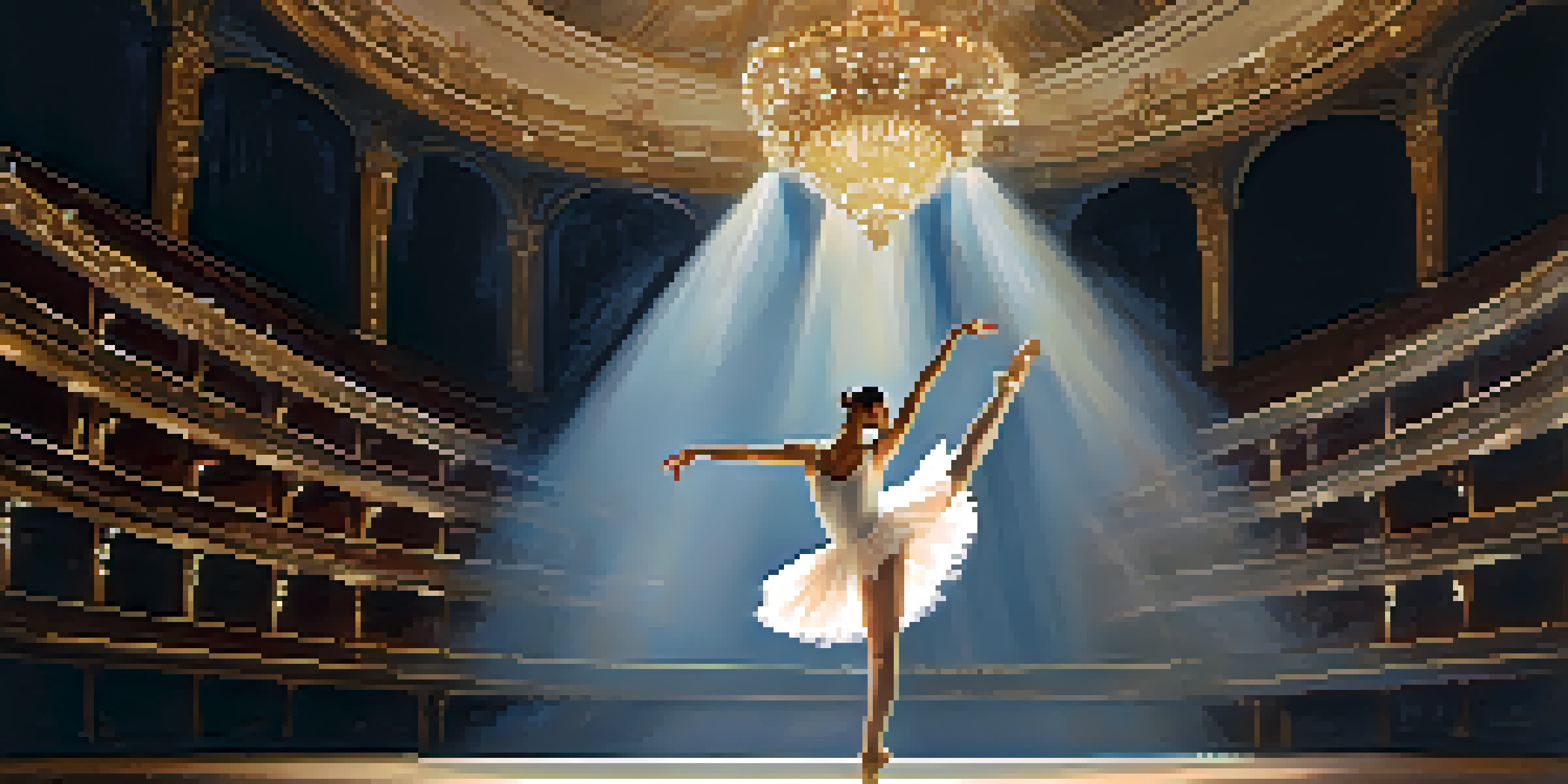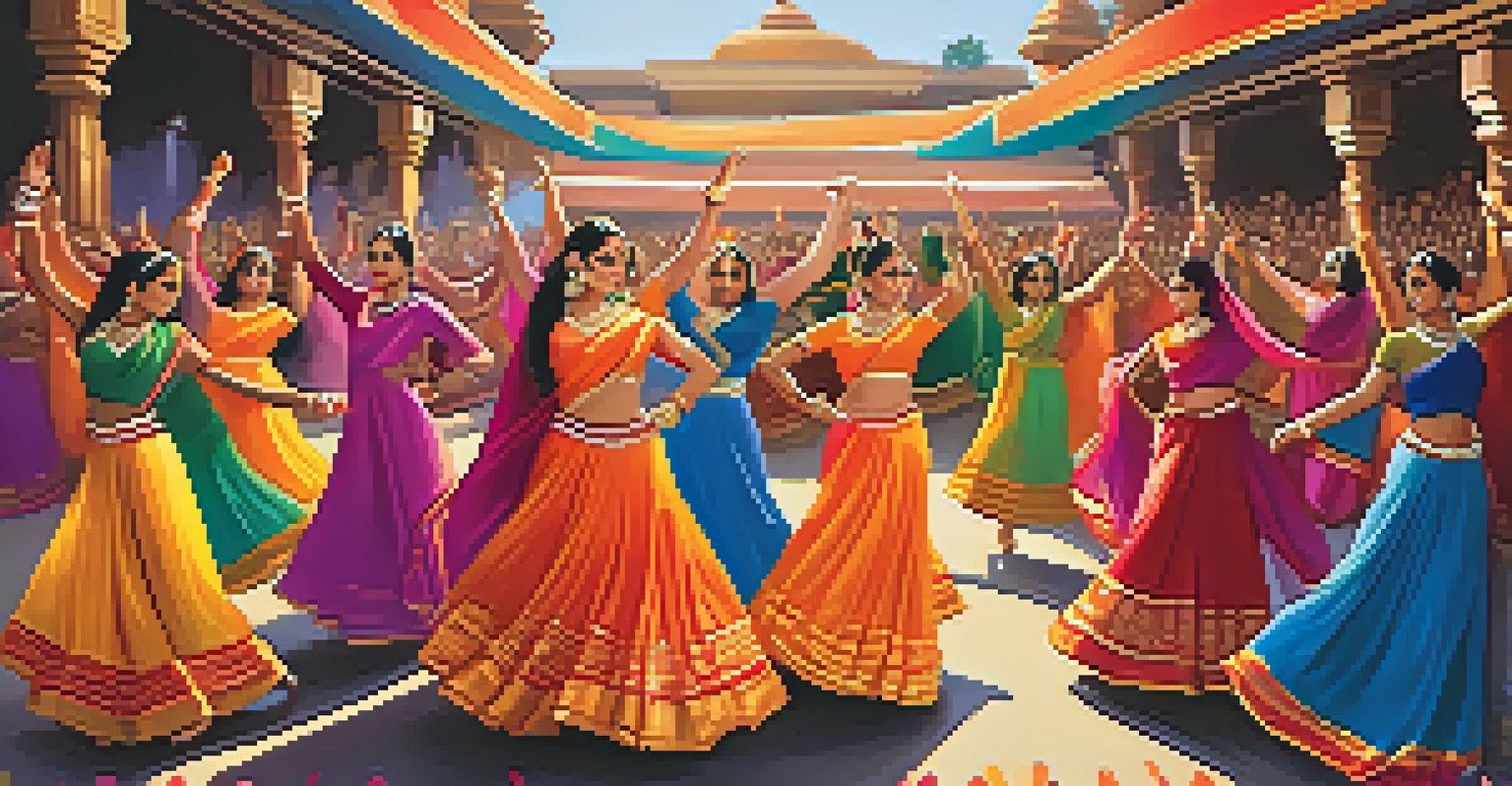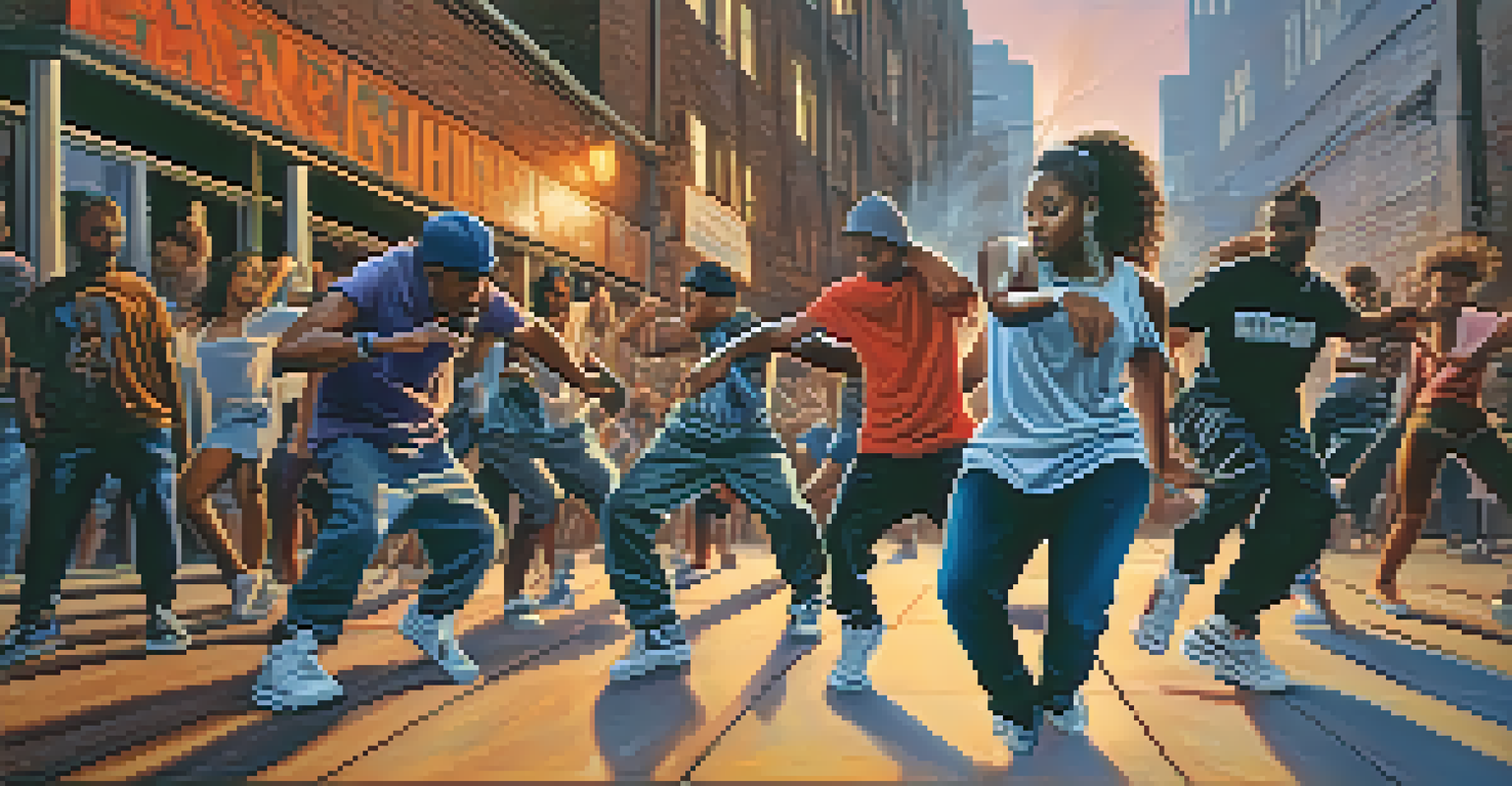Cross-Cultural Influences in Cinematic Dance Styles

The Essence of Dance: A Universal Language
Dance is often described as a universal language—one that transcends borders and connects people. When we watch a dance scene in a film, we’re not just seeing movement; we’re experiencing a cultural narrative. Each step, sway, and spin tells a story that resonates deeply with audiences, regardless of their backgrounds.
Dance is the hidden language of the soul.
For instance, Bollywood dance often integrates classical Indian elements with modern styles, creating a vibrant spectacle that captivates viewers. Similarly, hip-hop dance draws from African American culture while embracing influences from around the globe, reflecting the interconnected nature of our world. This blending of styles enriches cinematic storytelling and allows for greater emotional expression.
In essence, the way dance is portrayed in films serves as a mirror to society, showcasing the fluidity of cultural exchange. As filmmakers draw from various traditions, they not only celebrate diversity but also create a dialogue about identity and belonging through the medium of dance.
Historical Context: Dance Through the Ages
To understand the cross-cultural influences in cinematic dance, we must first explore the historical context of dance itself. Throughout history, dance has played a crucial role in rituals, celebrations, and storytelling across various cultures. From ancient tribal dances to the elegant court dances of Europe, each era and region has contributed to the rich tapestry of dance.

In film, these historical influences can be seen in the choreography and themes. For example, the influence of African dance traditions can be found in many contemporary dance films, celebrating the roots of these styles while also showcasing their evolution. By incorporating these historical elements, filmmakers not only pay homage to the past but also educate audiences about the significance of these cultural practices.
Dance as a Cultural Connector
Dance transcends cultural boundaries, serving as a universal language that connects people through storytelling.
Moreover, recognizing historical influences allows us to appreciate how far dance has come. It invites viewers to engage with the evolution of styles and understand the narratives behind them, fostering a deeper connection with the film’s message.
Cinematic Techniques: Visual Storytelling in Dance
Cinematic dance isn’t just about the choreography; it’s also about how dance is captured on screen. Filmmakers use various techniques to enhance the storytelling aspect of dance, from camera angles to editing styles. For instance, a close-up shot can highlight the emotional expression of a dancer, while wide shots can showcase the grandeur of a group performance.
Dance is the joy of movement and the heart of life.
Additionally, lighting and color play pivotal roles in setting the mood of a dance sequence. In movies like 'La La Land', vibrant colors and dynamic camera movements breathe life into the dance scenes, making them unforgettable. Such techniques ensure that the audience is not merely watching a dance but is drawn into the story being told.
This interplay between dance and cinematic techniques creates a unique viewing experience, allowing audiences to feel the rhythm and emotion of the performance while also engaging with the narrative. The result is a powerful fusion of art forms that captivates and inspires.
Globalization: The Blending of Dance Cultures
Globalization has significantly influenced the way dance is perceived and practiced around the world. With the rise of technology and social media, dance styles from different cultures can be shared and adapted rapidly. As a result, we see a fascinating blend of traditional and contemporary styles in films, reflecting a more interconnected world.
For example, K-Pop has taken the world by storm, incorporating various dance styles from hip-hop to jazz, and its impact is evident in global cinema. Films featuring K-Pop dance sequences often draw on this fusion, showcasing not just one culture but a vibrant tapestry of influences. This cross-pollination enriches the cinematic landscape and broadens the audience's appreciation for diverse dance forms.
Tech's Impact on Dance in Film
Advancements in technology enhance the representation of dance in cinema, allowing for innovative choreography and broader cultural expression.
In this way, globalization acts as a double-edged sword; while it promotes cultural exchange, it also raises questions about cultural appropriation. It’s essential for filmmakers to approach this blending with respect, ensuring that they celebrate and honor the origins of the dance styles they incorporate.
Influence of Technology on Dance Representation
Technology has revolutionized the way dance is created, shared, and experienced in cinema. From motion capture to advanced editing software, filmmakers can now bring intricate dance sequences to life in ways that were once unimaginable. This allows for more creative storytelling and a wider range of styles to be represented on screen.
For example, films like 'The Matrix' have used innovative technology to blend martial arts with dance-like choreography, creating visually stunning sequences that captivate audiences. Additionally, platforms like TikTok have democratized dance, allowing anyone to share their movements and inspire filmmakers to incorporate these grassroots styles into mainstream cinema.
Thus, technology not only enhances the visual appeal of dance but also serves as a bridge connecting various cultures and dance forms. As filmmakers embrace these advancements, they open up new avenues for creative expression and cultural representation.
Dance as a Reflection of Cultural Identity
Dance often serves as a powerful medium for expressing cultural identity, allowing individuals to connect with their heritage. In cinema, this is beautifully illustrated through dance sequences that celebrate specific cultural narratives. For instance, films like 'Coco' showcase traditional Mexican dance, emphasizing the importance of family and community in cultural preservation.
Moreover, these dance performances can spark conversations about identity and belonging, especially for marginalized communities. Through film, dancers can reclaim their narratives and showcase their unique cultural stories to a broader audience, fostering understanding and appreciation.
Diversity Shapes Future Dance Cinema
The future of cinematic dance will increasingly focus on diverse representation, celebrating various cultural identities and blending styles.
As a result, cinematic dance becomes more than just entertainment; it becomes a platform for cultural dialogue and expression. By highlighting diverse dance styles, filmmakers contribute to a richer understanding of the world and its myriad cultures.
The Future of Dance in Cinema: A Cultural Perspective
Looking ahead, the future of dance in cinema is undoubtedly bright, with an increasing emphasis on diversity and representation. As filmmakers become more aware of the importance of cultural authenticity, we can expect to see a wider array of dance styles being portrayed on screen. This shift not only enriches storytelling but also gives a voice to underrepresented cultures.
Moreover, as globalization continues to shape our world, the blending of various dance styles will likely become even more pronounced. Future films may feature innovative choreographies that draw from multiple traditions, creating fresh narratives that resonate with global audiences.

Ultimately, the evolution of cinematic dance will reflect the ongoing dialogue between cultures, celebrating our shared humanity while honoring our unique identities. This is an exciting time for filmmakers and dancers alike, as they collaborate to push the boundaries of artistic expression in cinema.